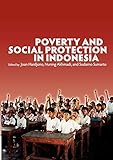Poverty and Social Protection in Indonesia / ed. by Joan Hardjono, Nuning Akhmadi, Sudarno Sumarto.
Material type: TextPublisher: Singapore : ISEAS Publishing, [2010]Copyright date: ©2010Description: 1 online resource (303 p.)Content type:
TextPublisher: Singapore : ISEAS Publishing, [2010]Copyright date: ©2010Description: 1 online resource (303 p.)Content type: - 9789812309396
- 9789812309525
- 330.9598 22
- HC450.P6 P67 2010
- HC450.P6 P67 2015
- online - DeGruyter
| Item type | Current library | Call number | URL | Status | Notes | Barcode | |
|---|---|---|---|---|---|---|---|
 eBook
eBook
|
Biblioteca "Angelicum" Pont. Univ. S.Tommaso d'Aquino Nuvola online | online - DeGruyter (Browse shelf(Opens below)) | Online access | Not for loan (Accesso limitato) | Accesso per gli utenti autorizzati / Access for authorized users | (dgr)9789812309525 |
Browsing Biblioteca "Angelicum" Pont. Univ. S.Tommaso d'Aquino shelves, Shelving location: Nuvola online Close shelf browser (Hides shelf browser)

|

|

|

|

|

|

|
||
| online - DeGruyter Older Persons in Southeast Asia : An Emerging Asset / | online - DeGruyter Southeast Asian Affairs 2009 / | online - DeGruyter Varieties of Religious Authority : Changes and Challenges in 20th Century Indonesian Islam / | online - DeGruyter Poverty and Social Protection in Indonesia / | online - DeGruyter Gender Trends in Southeast Asia : Women Now, Women in the Future / | online - DeGruyter Southeast Asia in a New Era : Ten Countries, One Region in ASEAN / | online - DeGruyter Divided Over Thaksin : Thailand's Coup and Problematic Transition / |
Frontmatter -- Contents -- LIST OF TABLES -- LIST OF Figures -- PREFACE -- Postscript: The 2008 Financial Crisis -- ACKNOWLEDGEMENTS -- GLOSSARY AND ACRONYMS -- The Editors -- The CONTRIBUTORS -- 1. A Brief Overview of Growth and Poverty in Indonesia during the New Order and after the Asian Economic Crisis -- Part One: Trends in Poverty and Technical Issues of Measurement -- 2. The Impact of the Economic Crisis on Consumption Expenditures and Poverty Incidence -- 3. Poverty and Vulnerability in Indonesia Before and After the Economic Crisis -- 4. Short-term Poverty Dynamics in Rural Indonesia during the Economic Crisis -- 5. The Evolution of Poverty during the Crisis in Indonesia -- Part Two: Poverty Alleviation Policies and Programs -- 6. Designs and Implementation of the Indonesian Social Safety Net Programs -- 7. Safety Nets or Safety Ropes? Dynamic Benefit Incidence of Two Crisis Programs in Indonesia -- 8. New Approaches to the Targeting of Social Protection Programs -- 9. Post-crisis Social Protection Programs in Indonesia -- 10. Conclusion: Coping with the Crisis -- Bibliography -- Index
restricted access online access with authorization star
http://purl.org/coar/access_right/c_16ec
This book consists of papers that present the findings of research done by the SMERU Research Institute in Jakarta, Indonesia. Most describe the effects on the poor of the Indonesian economic crisis of 1997-98 and the response of the Indonesian government in the form of a Social Safety Net consisting of poverty mitigation programs. With the gradual recovery of the economy after 2000, the Indonesian government began reducing subsidies for fuel products and has channelled budgetary savings into a new series of targeted social protection and poverty alleviation undertakings that include unconditional cash transfers. The effectiveness of Indonesia's poverty alleviation programs has, however, been reduced by the difficulty of targeting beneficiaries accurately because of a lack of reliable, up-to-date poverty figures. In many instances unsuitable targeting methodology has been compounded by bad governance at the local level, while the introduction of regional autonomy, accompanied by the decentralization of authority to the district level, has formed a further complicating factor.
Mode of access: Internet via World Wide Web.
In English.
Description based on online resource; title from PDF title page (publisher's Web site, viewed 01. Dez 2022)


